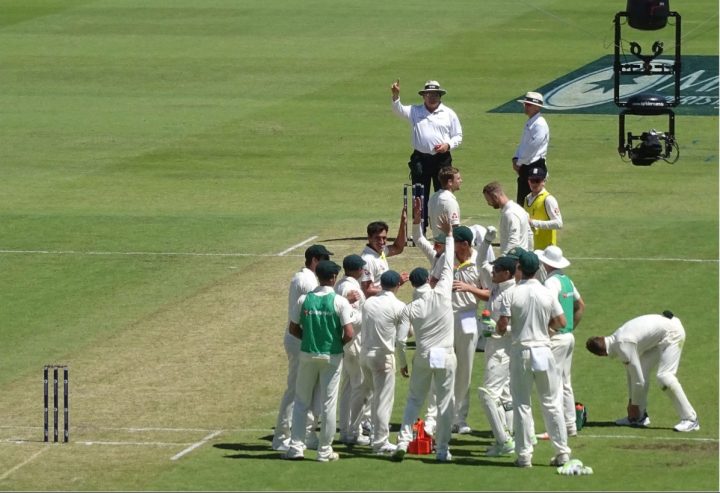Today we welcome 13-year old writer Rahul Palaninathan to TFT. I really like this topic. It’s a tribute to all those understated and underrated finger spinners out there.
The 2005 Ashes. A series that revived a national sport as the squashbuckling English team slew the legendary Australian juggernaut. It will go down in history as one of the greatest contests in the history of sport.
The English team was lauded by the whole country for its bravery and prowess but no one’s lives changed as drastically as it did for the two leading performers in this epic battle: Andrew Flintoff and Kevin Pietersen. Flintoff, for his never say die attitude and his reverse swinging cannon balls that zoomed past the batsmen’s futile defences, and Pietersen, for his jaw dropping stroke play as he arrogantly dispatched one of Wisden’s 5 cricketers of the 20th century. Both players became high profile heroes revered as the saviours of English cricket.
However, in that Ashes victory there was a man who did all the dirty work. He performed the job no one ever wanted to do. And that man was just as pivotal in the victory as the men who were commended by the media:
That man was the brilliant and understated Ashley Giles.
There are 2 types of spinners: the glamorous and unglamorous. The glamorous spinners are the ones that can turn it 2 feet and have more variations than I have fingers. The unglamorous ones are the ones prepared to put a shift in for the team with relentless accuracy.
Ashley Giles is the unglamorous type but his unselfishness, discipline, and his dedication to the team made him worth his weight in gold. Lacking the prodigious spin and revs that a bowler like Shane Warne produced in abundance, Ash made up for it in heart and willingness to do whatever it takes to help the team.
When it’s a sweltering hot day with the sun beating down without mercy and the fast bowlers are drenched with sweat and need a break, Ashley Giles is your man. He holds up an end and ensures pressure is maintained so the fast bowlers can reap rewards.
To be effective he has to land the ball on a 5 pence coin again and again. He has no room for error otherwise the batsmen will score a boundary and the pressure he’s building would be released.
And yet, somehow, Giles managed to build this indispensable pressure far more often than not.
There must be an enormous mental burden to land the ball on a spot every time. What’s more, it must be incredibly difficult to control your ego and not go searching for wickets. The discipline required cannot be understated.

The 2005 Ashes fast bowlers therefore owed a great debt to Ashley Giles. But not just them, every fast bowler that has a similar bowler in their team is in debt to that unglamorous spinner. After all, Ashley Giles is not the only bowler of this type as there have been many bowlers across time who have fulfilled this role.
Let’s have a look at some modern exponents of unglamorous spin:
Ravindra Jadeja is perhaps the best example. We all know what an X factor fielder he is, and it’s a well-known cricket trivia fact that he’s scored 3 first class triple hundreds. However, his bowling is as unglamorous as it gets.
Jadeja mostly relies on changes in pace but takes bags of wickets when conditions suit – especially at home. But in overseas conditions he is a different bowler. He uses his pinpoint accuracy to bowl a consistent line and length and occasionally uses a change of pace. His rapid run up also hurries the batsman and he is often called upon by Virat Kohli at the end of the day to squeeze in some extra overs.
Ravi’s accuracy and change of pace also make him a more than handy bowler in limited overs cricket. Combined with his all-round abilities, Jadeja is a wonderful 3-dimensional player that any side would love to have.
Nathan Lyon is another fine bowler. He’s a lethal attacking option when conditions suit but he can also play an excellent holding role when the pitch is more suited towards the big quicks. Having arguably the best fast bowling attack in the world around him, it is important that he can play a defensive holding role to maintain pressure so the fast bowlers can stay fresh.
Coupled with his unrelenting line and length, his extra bounce, and ability to bowl that ball that slides into the batsmen, it’s no wonder that Lyon has played almost a 100 test matches for Australia and has become his country’s most prolific off spinner.
Jadeja and Lyon are just two of the world’s unglamorous but effective spinners. There’s also Keshav Maharaj, Rakheem Cornwall, Washington Sundar, and Chris Green to mention a few. But why are these bowlers so unappreciated?
Back in the 1980s crowds like to see fast bowling and bouncer barrages. Spinners weren’t given much attention. And when a spinner did hit the headlines it was usually a leg spinner like Mushtaq Ahmed. Off spin just plodded along without any real progress.
Shane Warne’s famous ‘Gatting ball’ also put unglamorous spinners in the shade. Rather than wanting to be the next Curtly Ambrose or Courtney Walsh, many kids wanted to become the next Shane Warne. Overnight, Shane Warne became a de facto ambassador for leg spin bowling and also for glamorous spin.
Suddenly the emphasis went from reliability and economy to wicket taking potential – despite the fact that most leg spinners (the mere mortals) were potentially unreliable. Humble off spin became a lost art.
Fortunately, however, T20 teams understand the potential of having an accurate off spinner, even during the powerplays. For example, Chris Green, a bowler with no magic variations or tons of spin, was rewarded for his economic bowling in the powerplay with a monumental 7-year contract with the Sydney thunder.
Although the advent of DRS, and the emergence of bowlers like Graeme Swann have also boosted the profile of finger spin, T20 has played an important role in bringing orthodox spin bowlers back into fashion.
One hopes this trend carries on. Ugly ducklings can often turn into beautiful swans.
Rahul Palaninathan









Finger spinners will always be more unglamorous than wrist spinners as they’ll never have the same potential to turn the ball, which is what the crowd gasp at when they see the slow motion replays.
The action you can get on the ball with a wrist will always be greater than with your fingers. This means if you’re not taking wickets you seem to be leaking runs, so there’s more going on when the wrist spinner is operating, also they will generally be put on to take or even buy wickets, either way it’s a guarentee of action. For the finger spinner this is offset by the fact that’s it’s easier to be accurate when you’re not applying that action, so they are more often used to restrict scoring, which is not generally as appealing to the watching public, even though they generally bowl longer spells.
Wrist spin also seems to attract the more demonstrative personalities, though there are a number of notable exceptions to this, which again will draw the punters attention to them.
Of course not all wrist spinners are big turners of the ball. The third most successful in the game’s history, Anil Kumble, wasn’t. He relied on the most underrated aspect of bowling (at least in England), bounce. With some bounce and just a modicum of turn Kumble could be lethal. It was what the Essex brains-trust of Fletcher and Gooch missed when they tried to play him as a slow-medium in-swing bowler on the ‘brownwash’ tour. Kumble seems to me closer to Lyon in style than, say, Warne. Yasir Shah is also not a big turner of the ball.
Herath is the big example that a modern spinner can be successful without huge turn or some alleged mystery ball. One thing he had in common with Warne is he took hundreds of wickets with 50mph straight balls (mostly LBW, some bowled or caught around the bat). Persuading the batsman to play for non-existent turn is a supreme weapon.
Just a point about Giles, as a Warwick man who watched him a lot on the county scene.
He invariably seemed to come on and create difficulties for batsmen at that level.
Could never understand why he wasn’t more effective in the test arena.
He had an air of class at county level thats usually denotes a player can step up.
Much better batsman than most realise too, sometimes opening for his county.
You’d certainly class him as an all rounder at county level and a good fielder too.
I could never understand why our own King of Spain was for many a figure of fun.
I’d rather have him on my team than an unpredictable lefty like Phil Edmonds.
Would Edmonds have had such a run in tests if Emburey wasn’t at the other end?
Interesting to compare them with the Yorkshire spin twins, Carrick and Cope.
I’m not so sure that he wasn’t reasonably effective in the test team. Sure, if you compare him to his great Asian or Australian contemporaries he wasn’t, but his test record is considerably better than Emburey’s for example, who was considered a much better county spinner.
His strike rate also compares pretty favourably many other England spinners between 1914 and 2006–and without it coming at the expense of economy as with some more modern spinners. Apart from Emburey, it’s also a lot better than very well-respected county bowlers such as Titmus, Edmonds, Gifford, Illingworth, Hemmings and Pocock, and than his main contemporaries Tufnell and Croft.
A good finger spinner can use movement in the air as much as spin off the wicket. I think the description of the Lyon ball that slides into the bat rather underestimates something which is much more than a ball that goes on with the arm. I recall being bowled driving at Stephen Booth, the old Somerset SLA, and that ball swung in the air. Of course, such a ball is easy to deal with…….if you are expecting it and not looking to attack. It is the combination of variation and temptation which makes a good finger spinner more than meets the eye.
I never had a problem with Giles’ inclusion in the Test side, because he was the best of the few spinners available. He never let England down, and he could keep one end secure when necessary, something which had been a problem with a lot of our Test sides. He was a decent close fielder and looked quite at home with the bat. If there was a criticism of him, I suppose it was that he never went through a top Test side – there was never a ‘Giles’s Test’ – but he did take some important top order wickets and played a part in too many England victories to be included as an ugly duckling in my book.
Maybe there’s not a “Giles test” in the classic sense, but he was pretty key to the win in Karachi in 2000–and to the whole tour.
He was also mightily effective in the win in England against WI in 2004 (he took 18 wickets in the first two tests). I’m not sure if they’re included in your “top Test sides”, but their batting did include Gayle, Sarwan, Lara and Chanderpaul–it wasn’t that shabby. If my memory isn’t getting defective, I remember him bowling someone (I think Lara) through the gate with a ball that turned miles, a classic finger-spinner’s dismissal.
And, of course, he had the hex on that great Test batsman Tino Best!
I agree with all that. Also, maybe I’ve just wiped it from my brain, but I don’t remember anyone really getting after him successfully and forcing him out of the attack.
You forgot the best unglamorous finger-spinner of all: Rangana Herath. Tubby, orthodox, workmanlike and took 433 test wickets @ 28.